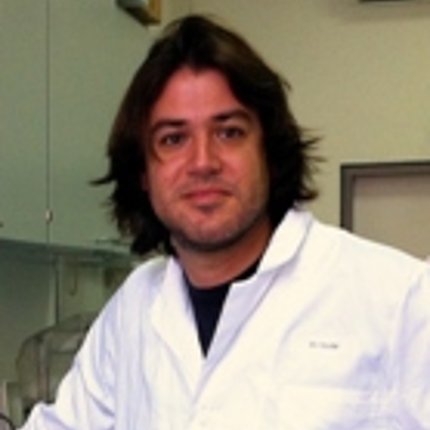Dr. rer. nat. Didier Soulat, Dipl Bioch.
Forschungsgruppenleiter

Lebenslauf, Veröffentlichungen und Auszeichnungen
Lebenslauf
Curriculum vitae
I defended my PhD in 2005 at the UCBL1 University (Lyon, France). My
PhD thesis aimed to characterize protein tyrosine kinase and phosphatase
activities from Staphylococcus aureus and defined their molecular mechanisms and
biological functions.This PhD in biochemistry was followed by a three year
postdoctoral stay in the laboratory of Prof. Thomas Decker in the Max F. Perutz
Laboratories (MFPL, Vienna, Austria). There, I studied the innate immune
response developed by mouse during an infection by Listeria monocytogenes
focusing on the function of type I interferon. In parallel, I initiated there
the study of a new virulence factor of L. monocytogenes: an atypical secreted
phosphatase named LipA.During a second postdoctoral stay in the laboratory
of Dr. Carlos Ardavin (CNB, Madrid, Spain), I continued to study innate
signaling in the context of fungal infection by Candida albicans focusing on the
role of dendritic cells during this infection.Since early 2012, I joined the
Mikrobiologisches Institut where I am developing a project aiming to define the
function of the Listeria virulence factor LipA.
___________________________________________________________________
Publications
- LipA, a tyrosine and lipid phosphatase involved in the virulence of Listeria monocytogenes. Kastner R, Dussurget O, Archambaud C, Kernbauer E, Soulat D*, Cossart P*, Decker T*. (2011) Infect. Immun. 79(6) :2489-98 (* Corresponding author)
- Characterization of the interferon-producing cell in mice infected with Listeria monocytogenes. Stockinger S, Kastner R, Kernbauer E, Pilz A, Westermayer S, Reutterer B, Soulat D, Stengl G, Vogl C, Frenz T, Waibler Z, Taniguchi T, Rülicke T, Kalinke U, Müller M, Decker T. (2009) PloS Pathog. 5(3):e1000355.
- The DEAD-box RNA helicase DDX3X is critical component of the TANK-binding kinase 1-dependent innate immune response. Soulat D., Bürckstümmer T., Westermayer S., Goncalves A., Bauch A., Preradovic A., Hantschel O., Bennet K.L., Decker T. and Superti-Furga G. (2008) EMBO J. 27(15):2135-46.
- Structural basis for the regulation mechanism of the tyrosine kinase CapB from Staphylococcus aureus. Olivares-Illana V., Meyer P., Gueguen-Chaignon V., Soulat D., Mijakovic I., Deutscher J., Cozzone A.J., Morera S., Grangeasse C., Nessler S. PLoS Biol. 10;6(6):e143.
- Type I IFN are host modulators of strain-specific Listeria monocytogenes virulence. Reutterer B., Stockinger S., Pilz A., Soulat D., Kastner R., Westermayer S., Rülicke T., Müller M. and Decker T. (2008) Cell. Microbiol. 10(5):1116-29
- UDP-Acetyl-mannosamine dehydrogenase is an endogenous protein substrate of Staphylococcus aureus protein-tyrosine kinase activity. Soulat D., Grangeasse C., Vaganay E., Cozzone A.J. and Duclos, B. (2007) J. Mol. Microbiol. Biotechnol. 13 (1-3):45-54.
- Tyrosine-kinase Wzc from Escherichia coli possesses an ATPase activity regulated by autophosphorylation. Soulat D., Jault J.M., Geourjon C., Gouet P., Cozzone A.J., Grangeasse C. (2007) FEMS Microbiol Lett. 274(2):252-9.
- Cytoplasmic Listeria monocytogenes stimulates IFN-beta synthesis without requiring the adapter protein MAVS. Soulat D., Bauch A., Stockinger S., Superti-Furga G., Decker T. (2006). FEBS Lett.;580(9):2341-2346.
- Staphylococcus aureus operates protein-tyrosine phosphorylation through a specific mechanism. Soulat D., Jault J.M., Duclos B., Geourjon C., Cozzone A.J., Grangeasse C. (2006). J. Biol. Chem.;281(20):14048-56.
- Two FHA domains on an ABC transporter, Rv1747, mediate its phosphorylation by PknF, a Ser/Thr protein kinase from Mycobacterium tuberculosis. Molle V., Soulat D., Jault J.M., Grangeasse C., Cozzone A.J., Prost J.F. (2004) FEMS Microbiol. Lett.;234(2):215-23.
- Staphylococcus aureus contains two low-molecular-mass phosphotyrosine protein phosphatases. Soulat D., Vaganay E., Duclos B., Genestier A.L., Etienne J., Cozzone A.J. (2002) J. Bacteriol.;184(18):5194-9.





